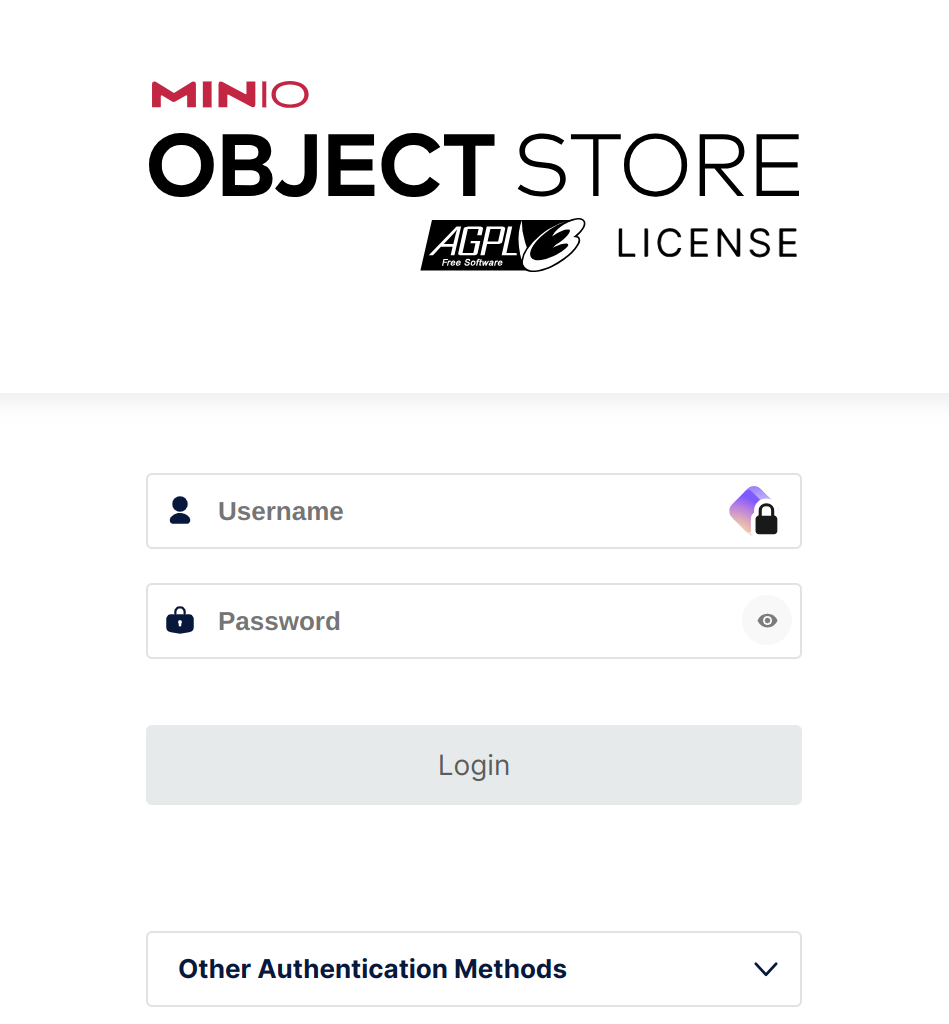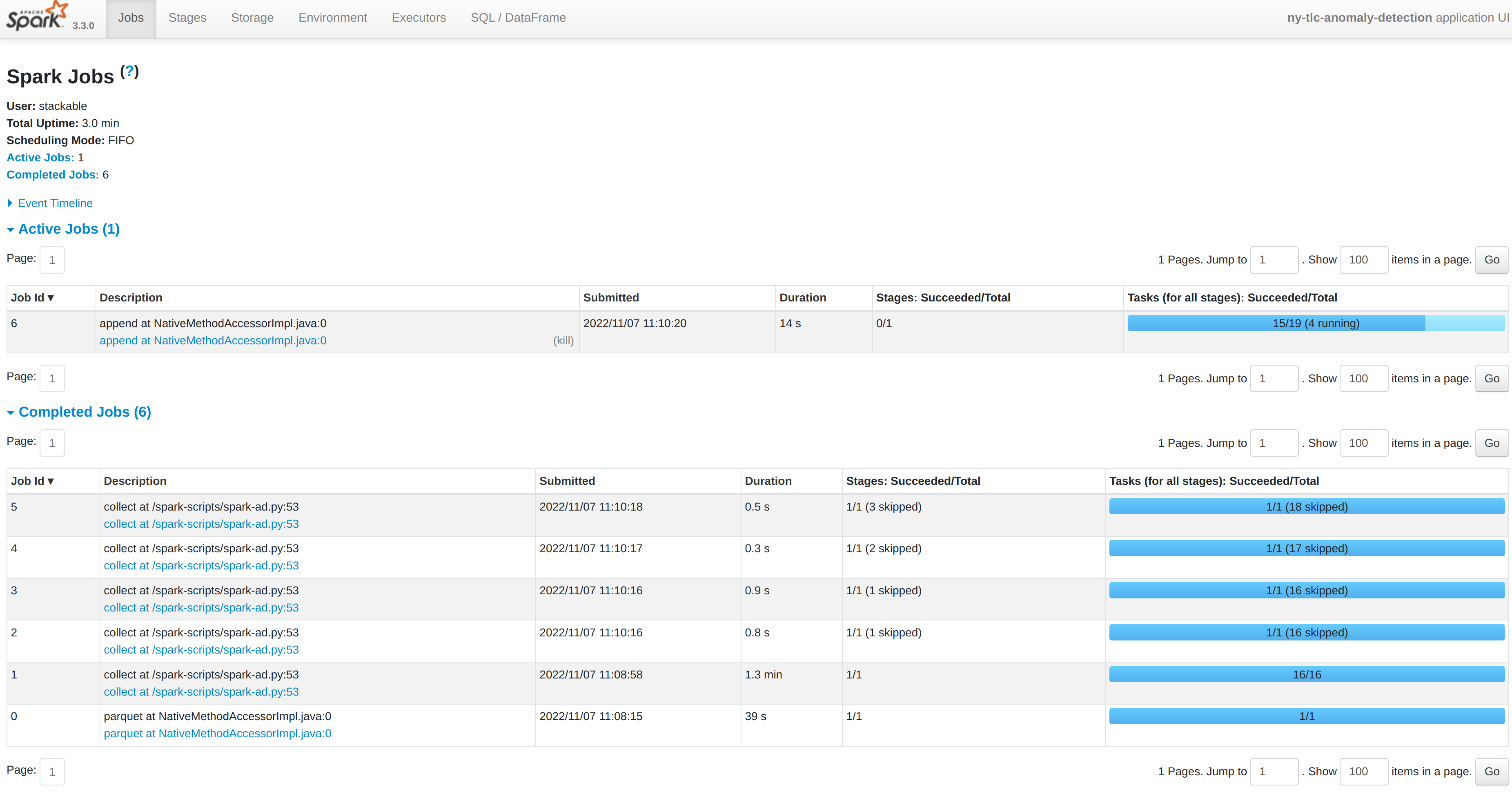spark-k8s-anomaly-detection-taxi-data
Install this demo on an existing Kubernetes cluster:
$ stackablectl demo install spark-k8s-anomaly-detection-taxi-data|
This demo should not be run alongside other demos. |
System Requirements
To run this demo, your system needs at least:
-
8 cpu units (core/hyperthread)
-
32GiB memory
-
35GiB disk storage
Overview
This demo will
-
Install the required Stackable operators.
-
Spin up the following data products:
-
Trino: A fast distributed SQL query engine for big data analytics that helps you explore your data universe. This demo uses it to enable SQL access to the data.
-
Spark: A multi-language engine for executing data engineering, data science, and machine learning. This demo uses it to batch-process data from S3 by training and scoring an unsupervised anomaly detection model and writing the results into a Trino table. Spark uses an isolation forest algorithm from the scikit-learn machine learning library in this demo.
-
MinIO: A S3 compatible object store. This demo uses it as persistent storage to store all the data used
-
Hive metastore: A service that stores metadata related to Apache Hive and other services. This demo uses it as metadata storage for Trino and Spark.
-
Open policy agent (OPA): An open-source, general-purpose policy engine unifies policy enforcement across the stack. This demo uses it as the authorizer for Trino, which decides which user can query which data.
-
Superset: A modern data exploration and visualization platform. This demo utilizes Superset to retrieve data from Trino via SQL queries and build dashboards on top of that data.
-
-
Copy the taxi data in parquet format into the S3 staging area.
-
A Spark batch job is started, which fetches the raw data, trains and scores a model, writing out the results to Trino/S3 for use by Superset.
-
Create Superset dashboards for visualization of the anomaly detection scores.
You can see the deployed products and their relationship in the following diagram:

List the deployed Stackable services
To list the installed Stackable services run the following command:
$ stackablectl stacklet list
PRODUCT NAME NAMESPACE ENDPOINTS EXTRA INFOS
hive hive spark-k8s-ad-taxi-data hive 172.18.0.2:31912
metrics 172.18.0.2:30812
hive hive-iceberg spark-k8s-ad-taxi-data hive 172.18.0.4:32133
metrics 172.18.0.4:32125
opa opa spark-k8s-ad-taxi-data http http://172.18.0.3:31450
superset superset spark-k8s-ad-taxi-data external-superset http://172.18.0.2:31339 Admin user: admin, password: adminadmin
trino trino spark-k8s-ad-taxi-data coordinator-metrics 172.18.0.3:32168
coordinator-https https://172.18.0.3:31408
minio minio-trino spark-k8s-ad-taxi-data http http://172.18.0.3:30589 Third party service
console-http http://172.18.0.3:31452 Admin user: admin, password: adminadmin|
When a product instance has not finished starting yet, the service will have no endpoint. Depending on your internet connectivity, creating all the product instances might take considerable time. A warning might be shown if the product is not ready yet. |
MinIO
List Buckets
The S3 provided by MinIO is used as persistent storage to store all the data used. Open the endpoint console-http
retrieved by stackablectl stacklet list in your browser (http://172.18.0.3:31452 in this case).

Log in with the username admin and password adminadmin.

Here, you can see the two buckets the S3 is split into:
-
demo: The demo loads static datasets into this area. It is stored in parquet format. It forms the basis for the model that Spark will train. -
prediction: This bucket is where the model scores persist. The data is stored in the Apache Iceberg table format.
Inspect raw data
Click on the blue button Browse on the bucket demo.

A folder (called prefixes in S3) contains a dataset of similarly structured data files. The data is partitioned by month and contains several hundred MBs, which may seem small for a dataset. Still, the model is a time-series model where the data has decreasing relevance the "older" it is, especially when the data is subject to multiple external factors, many of which are unknown and fluctuating in scope and effect.
The second bucket prediction contains the output from the model scoring process:

This is a much smaller file, as it only contains scores for each aggregated period.
Spark
The Spark job ingests the raw data and performs straightforward data wrangling and feature engineering. Any windowing features designed to capture the time-series nature of the data - such as lags or rolling averages - need to use evenly distributed partitions so that Spark can execute these tasks in parallel. The job uses an implementation of the Isolation Forest algorithm provided by the scikit-learn library: the model is trained in a single task but is then distributed to each executor from where a user-defined function invokes it (see this article for how to call the sklearn library with a pyspark UDF). The Isolation Forest algorithm is used for unsupervised model training, meaning that a labelled set of data - against which the model is trained - is unnecessary. This makes model preparation easier as we do not have to divide the data set into training and validation datasets.
You can inspect a running Spark job by forwarding the port used by the Spark-UI:
$ kubectl port-forward spark-ad-driver 4040and then opening a browser tab to http://localhost:4040:

Dashboard
The anomaly detection dashboard is pre-defined and accessible under Dashboards when logged in to Superset:

The model does not yield data that can be used directly for a root cause analysis. An isolation forest is a type of random forest that measures how many branches are needed in its underlying decision trees to isolate each data point: the more abnormal the data, the easier this will be - a clear outlier may only need a single partition to isolate it, whereas tightly clustered data will require significantly more. The number of partitions to isolate is, therefore, in inverse proportion to the anomaly-ness of the data.